unit 2 教案
人教PEP版六年级英语上册《Unit2》精品教案教学设计小学优秀公开课8

人教PEP版六年级英语上册第二单元教案Unit2Ways to go to school教学设计二、呈现(Presentatio n)1.main scene学习(1)呈现图片,仔细观察图片,回答问题,Where are they?What can you see?(2)学生仔细观察图片,展开合理想象并回答老师的问题。
Where are they?What can you see?(3)听录音,模仿朗读,理解对话内容。
①指明朗读对话,并翻译主要句子的中文意思,掌握单词、句子的读法。
2教师领读对话,学生模仿,齐读,生生对话,小组表演。
3告诉学生应该遵守交通规则,红灯停,绿灯行。
2.学习Let’s try&Let’s talk(1)T:Today I come to school on bus.Iusually come to school on foot.Whatabout you?Do you come by bike or bybus?Do you come on foot or by car?(2)Listen to the tape(3)快速反应游戏:教师说出某个短语,让学生做相应的动作并说出句子(4)听录音,跟读Let’s talk内容,注意纠正学生的发音(5)图片解释usually/often/sometimes单词的区别。
(100%80%60%40%0)(6)同桌表演对话,培养学生学习语言,课堂上激发学生不断地去说,再引入课文内容的学习。
1、free talk形式,先跟学生展开对话,让学生在学习新内容前先巩固已学过的知识。
2、通过听、游戏、动作去了解短文意思,并通过学习,引出频率副词的学习,让学生自然而然地掌握,了解所发生频率不一样,需要用不同的频率副词。
三、操练(Practice )1.Listen to the tape.Listen to the tape and read after it.2.Play a chain game教师做动作,自问自答:How doI come to school?I come to school by bike,继续重复刚才的句子并问某一位学生,继续传递下去。
初一英语教案人教版unit2

教案初一英语教案人教版unit2一、引言1.1课题背景1.1.1英语作为国际通用语言的重要性1.1.2我国英语教育的发展及现状1.1.3初一英语学习的阶段特点及任务1.1.4Unit2在初一英语教学中的地位和作用1.2教学目标1.2.1培养学生英语学习的兴趣和积极性1.2.2提高学生的英语听说读写能力1.2.3培养学生的跨文化交际意识1.2.4帮助学生掌握Unit2的知识点1.3教学方法1.3.1采用任务型教学法,激发学生的学习兴趣1.3.2利用多媒体辅助教学,提高教学效果1.3.3鼓励学生参与课堂互动,培养合作精神1.3.4定期进行学习评价,及时调整教学方法二、知识点讲解2.1词汇2.1.1重点词汇:family,parent,sister,brother,grandparent 2.1.2词汇讲解:通过图片、实物等形式展示词汇,让学生更好地理解和记忆2.1.3词汇练习:设计丰富的练习,如填空、选择、匹配等,巩固学生对词汇的掌握2.1.4词汇运用:鼓励学生在实际情景中运用所学词汇,提高语言运用能力2.2语法2.2.1重点语法:一般现在时2.2.2语法讲解:通过例句、图表等形式讲解一般现在时的构成和用法2.2.3语法练习:设计针对性的练习,如填空、改错、句型转换等,让学生熟练掌握一般现在时2.2.4语法运用:鼓励学生在写作、口语表达中运用一般现在时,提高语法运用能力2.3对话2.3.1重点对话:介绍家庭成员2.3.2对话讲解:分析对话内容、功能及语言特点2.3.3对话练习:设计角色扮演、问答等练习,让学生熟悉并运用对话2.3.4对话拓展:鼓励学生结合自身实际,创作类似的对话,提高交际能力三、教学内容3.1课文3.1.1课文内容:Unit2的课文主要围绕家庭成员展开3.1.2课文讲解:分析课文结构、语言点及文化背景3.1.3课文练习:设计阅读理解、完型填空等练习,提高学生的阅读能力3.1.4课文拓展:引导学生探讨课文主题,培养学生的思辨能力和跨文化意识3.2听力3.2.1听力材料:与家庭成员相关的对话、短文等3.2.2听力讲解:教授听力技巧,如预测、捕捉关键信息等3.2.3听力练习:设计听辨、听写、听力理解等练习,提高学生的听力水平3.3语音3.3.1重点语音:元音音素/i:/和/i/3.3.2语音讲解:讲解元音音素的发音特点及区别3.3.3语音练习:设计听音辨词、模仿朗读等练习,让学生掌握元音音素的发音3.3.4语音拓展:引导学生关注日常生活中的语音现象,提高语音感知能力四、教学目标4.1知识与技能4.1.1掌握Unit2的重点词汇、语法和对话4.1.2能够运用Unit2的知识进行简单的英语交际4.1.3提高英语听说读写能力4.1.4培养跨文化交际意识4.2过程与方法4.2.1培养学生合作学习的能力4.2.2培养学生自主学习的能力4.2.3培养学生解决问题的能力4.2.4培养学生创新思维的能力4.3情感态度与价值观4.3.1培养学生对英语学习的兴趣和积极性4.3.2培养学生尊重和包容不同文化的态度4.3.3培养学生团队合作的精神4.3.4培养学生积极向上的价值观五、教学难点与重点5.1教学难点5.1.1词汇的掌握和运用5.1.2一般现在时的语法运用5.六、教具与学具准备6.1教师准备6.1.1多媒体课件:包括词汇、语法、对话的展示和练习6.1.2图片和实物:用于展示家庭成员,增强视觉效果6.1.3录音设备:播放听力材料,进行听力练习6.1.4教学视频:用于辅助教学,提供更多的语言输入6.2学生准备6.2.1英语课本和练习册:学习Unit2的相关内容6.2.2笔记本和文具:记录重点知识和练习答案6.2.3家庭照片:用于介绍家庭成员的实践活动6.2.4英语词典:查找生词,自主学习6.3课堂环境6.3.1座位安排:适合小组活动和角色扮演6.3.2黑板和白板:用于板书和展示学生答案6.3.3墙面海报:展示英语学习标语和家庭成员词汇七、教学过程7.1导入7.1.1开场白:用英语与学生打招呼,引入新课话题7.1.2快速问答:复习上一课的内容,激活学生的相关知识7.1.3图片展示:展示家庭成员的图片,引起学生的兴趣7.1.4目标介绍:告知学生本节课的学习目标和预期成果7.2主体教学7.2.1词汇学习:通过图片和实物学习重点词汇7.2.2语法讲解:通过例句和图表讲解一般现在时7.2.3对话练习:分组练习对话,模拟真实场景7.2.4听力训练:播放听力材料,进行听力和理解练习7.3巩固与拓展7.3.1小组活动:设计家庭成员介绍的小游戏或角色扮演7.3.2课堂写作:写一段关于自己家庭成员的短文7.3.3语音练习:模仿录音,练习元音音素的发音7.3.4作业布置:布置课后作业,巩固所学知识八、板书设计8.1词汇板书8.1.1重点词汇列表:在黑板上列出Unit2的重点词汇8.1.2词汇例句:用不同颜色的粉笔标出词汇在例句中的使用8.1.3词汇配图:在词汇旁边画上简笔画,增强记忆8.1.4词汇游戏:设计一个与词汇相关的游戏,如“找不同”8.2语法板书8.2.1语法规则:用图表形式展示一般现在时的构成8.2.2语法例句:用例句展示一般现在时的用法8.2.3语法练习:在黑板上展示语法练习题,让学生参与解答8.3对话板书8.3.1对话脚本:在黑板上写出对话的脚本,供学生参考8.3.2对话角色:标明对话中不同角色的名称8.3.3对话情景:用图画或关键词表示对话发生的情景8.3.4对话提示:给出表演对话时的表情和动作提示九、作业设计9.1词汇作业9.1.1词汇填空:完成练习册上的词汇填空题9.1.2词汇匹配:将词汇与图片或定义进行匹配9.1.3词汇造句:用Unit2的词汇各造一个句子9.1.4词汇复习:复习Unit2的所有词汇,准备下次课的测试9.2语法作业9.2.1语法改错:改正练习册上的语法错误9.2.2语法填空:完成一般现在时的语法填空题9.2.3语法转换:将句子从一般现在时转换为其他时态9.2.4语法写作:用一般现在时写一段短文9.3对话作业9.3.1对话背诵:背诵Unit2的对话9.3.2对话改编:改编Unit2的对话,加入自己的家庭成员9.3.3对话表演:与同学一起表演Unit2的对话9.3.4对话创作:创作一个新的对话,介绍自己的家庭成员十、课后反思及拓展延伸10.1教学效果反思10.1.1学生参与度:重点和难点解析一、知识点讲解中的词汇部分1.1词汇的讲解与练习详细讲解每个重点词汇的用法和搭配,确保学生理解并能够正确使用。
Unit-2-The-Olympic-Games教案

Unit-2-The-Olympic-Games教案(jiào àn)Unit-2-The-Olympic-Games教案(jiào àn)Unit 2 The Olympic GamesI.教学内容分析(fēnxī)本单元的中心(zhōngxīn)话题是“奥运会”。
Warming Up部分通过讨论让学生了解古代和现代(xiàndài)奥运会的异同。
Pre-reading部分的三个问题则进一步考查学生(xué sheng)对奥运会基本常识的了解。
Reading部分作者通过一个虚拟(xūnǐ)的采访向读者介绍了古代奥运会与现代奥运会的异同。
Comprehending部分帮助学生归纳他们已知的和刚学到的关于古代与现代奥运会异同,并且进一步讨论奥运会相关知识。
Learning about Language部分都同单元主题紧密相关,词汇和语法结构的呈现也尽可能地安排在相关的语境中。
Using Language部分通过一个希腊神话故事来引导学生进行读、听、说、写的综合训练。
Learning Tip部分鼓励学生在两人活动和小组活动中积极发言(fā yán),这样既可以消除害羞的心理,又有利于学生掌握恰当的交际策略。
II.教学重点(zhòngdiǎn)和难点1.教学(jiāo xué)重点(zhòngdiǎn)(1) 本单元的生词(shēngcí)和短语;(2)学会使用将来时的被动语态;(3)让学生熟悉奥运会—世界上最重要的体育盛会;能用英语就奥运会的基本知识进行互相问答,并能简述奥运会的基本知识;(4)鼓励学生表达自己的兴趣爱好,要多让学生讲自己熟悉的话题。
2.教学难点(1) 指导学生按类别归纳整理词汇,让学生学会有效的记忆词汇的方法;(2) 引导学生发现本单元重点语言结构,让学生自己发现并感悟相关的语言规律,培养他们的语感。
教师备课——英语七年级下UNIT2教案2
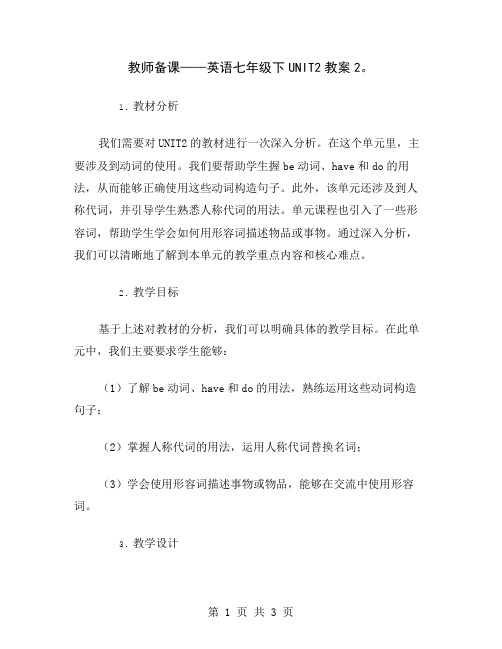
教师备课——英语七年级下UNIT2教案2。
1.教材分析我们需要对UNIT2的教材进行一次深入分析。
在这个单元里,主要涉及到动词的使用。
我们要帮助学生握be动词、have和do的用法,从而能够正确使用这些动词构造句子。
此外,该单元还涉及到人称代词,并引导学生熟悉人称代词的用法。
单元课程也引入了一些形容词,帮助学生学会如何用形容词描述物品或事物。
通过深入分析,我们可以清晰地了解到本单元的教学重点内容和核心难点。
2.教学目标基于上述对教材的分析,我们可以明确具体的教学目标。
在此单元中,我们主要要求学生能够:(1)了解be动词、have和do的用法,熟练运用这些动词构造句子;(2)掌握人称代词的用法,运用人称代词替换名词;(3)学会使用形容词描述事物或物品,能够在交流中使用形容词。
3.教学设计基于教材分析和教学目标,我们需要进行详细的教学设计。
我们可以通过提供一些生动的语言材料,向学生展示be动词、have和do 的用法。
在这个过程中,可以帮助学生发现一些常见的语言规律和用法,如肯定句、否定句和疑问句等。
同时,也可以通过练习帮助学生熟悉这些动词的使用方法。
我们可以引导学生熟悉人称代词的使用。
通过对语言材料的分析和练习,学生可以逐渐理解代词在句子中的作用和用法,并掌握有效地使用人称代词进行交际的技能。
我们可以引入形容词,让学生重点了解形容词与名词搭配方法,并且在生活实践中加强彼此搭配的印象。
在此过程中,教师要注意语言的生动性和趣味性,让学生更好地理解用法,同时,鼓励他们在交流中积极运用词汇。
4.教学评估在教学过程中,我们需要对学生的掌握情况进行评估。
在这个过程中,我们可以使用各种形式的评估方法,如听力、口语、阅读和写作等,以帮助学生全面地巩固并使用教材中的词汇和语法。
5.课后回顾最后要注意的是,教师在教学结束后,应该对教学过程进行总结和回顾,以保证学生可以更好地理解和掌握所学的内容。
在回顾过程中,可以和学生讨论一些重点难点,从而加深对其的印象,巩固所学的知识。
人教版八年级英语上册教材Unit2 教案
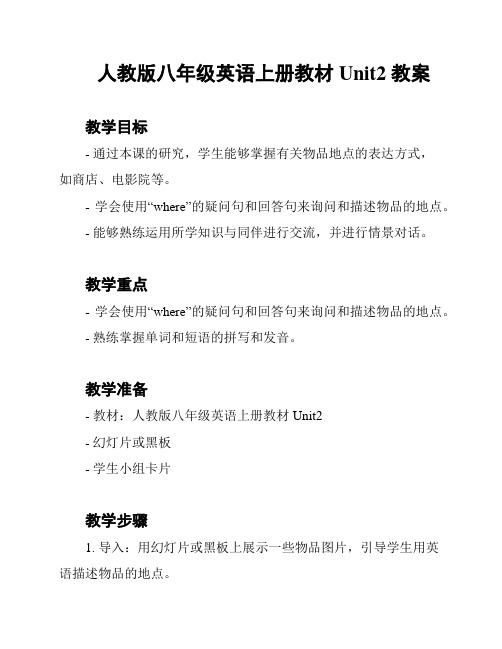
人教版八年级英语上册教材Unit2 教案
教学目标
- 通过本课的研究,学生能够掌握有关物品地点的表达方式,
如商店、电影院等。
- 学会使用“where”的疑问句和回答句来询问和描述物品的地点。
- 能够熟练运用所学知识与同伴进行交流,并进行情景对话。
教学重点
- 学会使用“where”的疑问句和回答句来询问和描述物品的地点。
- 熟练掌握单词和短语的拼写和发音。
教学准备
- 教材:人教版八年级英语上册教材Unit2
- 幻灯片或黑板
- 学生小组卡片
教学步骤
1. 导入:用幻灯片或黑板上展示一些物品图片,引导学生用英
语描述物品的地点。
2. 研究新知:通过教材Unit2的相关内容,教授目标词汇和短语,让学生理解并记忆。
3. 练活动:进行对话练,学生分组,每个小组选择一个物品进行情景对话,询问和回答物品的地点。
4. 拓展活动:让学生运用所学知识,创造自己的对话,交流物品的地点。
5. 归纳总结:让学生回顾所学知识,进行总结归纳。
6. 作业布置:布置课后作业,要求学生练复述本课内容,并使用疑问句和回答句描述物品地点。
教学评价
- 通过学生的课堂表现、练活动和讨论活动来进行评价,检查学生是否能够正确运用所学语言进行物品地点的描述。
- 提供及时的反馈,鼓励学生用英语进行交流。
注意事项
- 确保课堂秩序,引导学生积极参与。
- 注重学生的口语能力培养,鼓励他们进行对话练。
- 提供足够的练机会,让学生熟练掌握所学知识。
以上为人教版八年级英语上册教材Unit2的教案,根据课堂实际情况适当调整教学步骤。
Unit 2 Traveling Around 教案
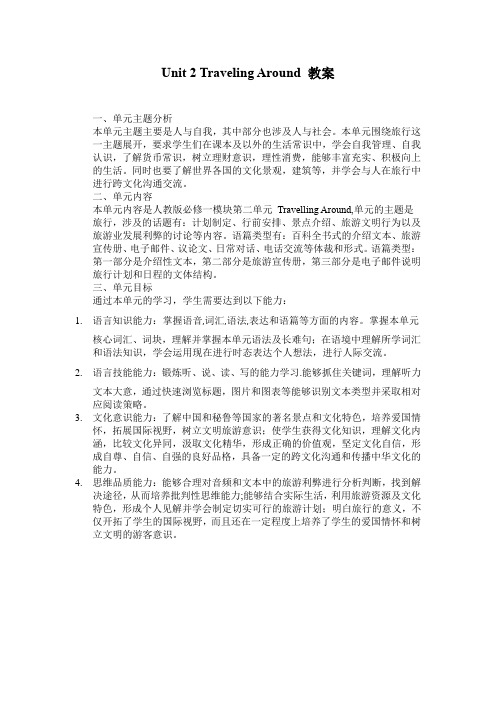
Unit 2 Traveling Around 教案一、单元主题分析本单元主题主要是人与自我,其中部分也涉及人与社会。
本单元围绕旅行这一主题展开,要求学生们在课本及以外的生活常识中,学会自我管理、自我认识,了解货币常识,树立理财意识,理性消费,能够丰富充实、积极向上的生活。
同时也要了解世界各国的文化景观,建筑等,并学会与人在旅行中进行跨文化沟通交流。
二、单元内容本单元内容是人教版必修一模块第二单元Travelling Around,单元的主题是旅行,涉及的话题有:计划制定、行前安排、景点介绍、旅游文明行为以及旅游业发展利弊的讨论等内容。
语篇类型有:百科全书式的介绍文本、旅游宣传册、电子邮件、议论文、日常对话、电话交流等体裁和形式。
语篇类型:第一部分是介绍性文本,第二部分是旅游宣传册,第三部分是电子邮件说明旅行计划和日程的文体结构。
三、单元目标通过本单元的学习,学生需要达到以下能力:1.语言知识能力:掌握语音,词汇,语法,表达和语篇等方面的内容。
掌握本单元核心词汇、词块,理解并掌握本单元语法及长难句;在语境中理解所学词汇和语法知识,学会运用现在进行时态表达个人想法,进行人际交流。
2.语言技能能力:锻炼听、说、读、写的能力学习.能够抓住关键词,理解听力文本大意,通过快速浏览标题,图片和图表等能够识别文本类型并采取相对应阅读策略。
3.文化意识能力:了解中国和秘鲁等国家的著名景点和文化特色,培养爱国情怀,拓展国际视野,树立文明旅游意识;使学生获得文化知识,理解文化内涵,比较文化异同,汲取文化精华,形成正确的价值观,坚定文化自信,形成自尊、自信、自强的良好品格,具备一定的跨文化沟通和传播中华文化的能力。
4.思维品质能力:能够合理对音频和文本中的旅游利弊进行分析判断,找到解决途径,从而培养批判性思维能力;能够结合实际生活,利用旅游资源及文化特色,形成个人见解并学会制定切实可行的旅游计划;明白旅行的意义,不仅开拓了学生的国际视野,而且还在一定程度上培养了学生的爱国情怀和树立文明的游客意识。
Unit2单元听力教案
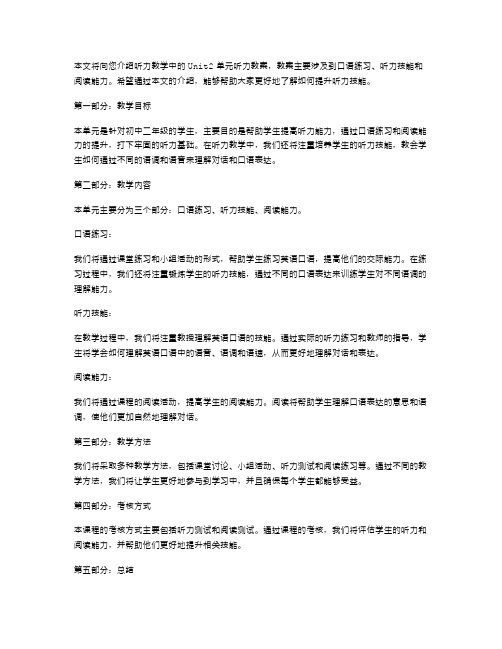
本文将向您介绍听力教学中的Unit2单元听力教案,教案主要涉及到口语练习、听力技能和阅读能力。
希望通过本文的介绍,能够帮助大家更好地了解如何提升听力技能。
第一部分:教学目标本单元是针对初中二年级的学生,主要目的是帮助学生提高听力能力,通过口语练习和阅读能力的提升,打下牢固的听力基础。
在听力教学中,我们还将注重培养学生的听力技能,教会学生如何通过不同的语调和语音来理解对话和口语表达。
第二部分:教学内容本单元主要分为三个部分:口语练习、听力技能、阅读能力。
口语练习:我们将通过课堂练习和小组活动的形式,帮助学生练习英语口语,提高他们的交际能力。
在练习过程中,我们还将注重锻炼学生的听力技能,通过不同的口语表达来训练学生对不同语调的理解能力。
听力技能:在教学过程中,我们将注重教授理解英语口语的技能。
通过实际的听力练习和教师的指导,学生将学会如何理解英语口语中的语音、语调和语速,从而更好地理解对话和表达。
阅读能力:我们将通过课程的阅读活动,提高学生的阅读能力。
阅读将帮助学生理解口语表达的意思和语调,使他们更加自然地理解对话。
第三部分:教学方法我们将采取多种教学方法,包括课堂讨论、小组活动、听力测试和阅读练习等。
通过不同的教学方法,我们将让学生更好地参与到学习中,并且确保每个学生都能够受益。
第四部分:考核方式本课程的考核方式主要包括听力测试和阅读测试。
通过课程的考核,我们将评估学生的听力和阅读能力,并帮助他们更好地提升相关技能。
第五部分:总结通过本单元的学习,学生将更好地理解英语口语,掌握英语语调和语音的技能。
同时,我们还将通过阅读能力的提升,帮助学生更好地理解口语表达的意思和语调。
因此,在接下来的学习中,学生将能够更好地应对英语口语的挑战,从而更加自信地参与到英语学习中去。
unit2教案
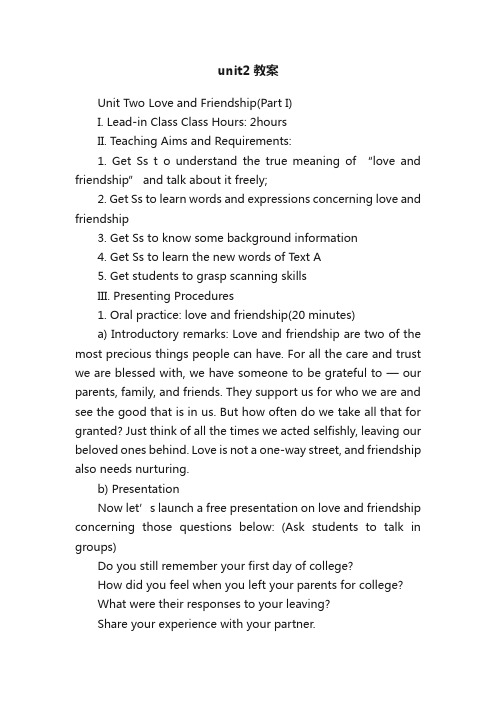
unit2教案Unit Two Love and Friendship(Part I)I. Lead-in Class Class Hours: 2hoursII. Teaching Aims and Requirements:1. Get Ss t o understand the true meaning of “love and friendship” and talk about it freely;2. Get Ss to learn words and expressions concerning love and friendship3. Get Ss to know some background information4. Get Ss to learn the new words of T ext A5. Get students to grasp scanning skillsIII. Presenting Procedures1. Oral practice: love and friendship(20 minutes)a) Introductory remarks: Love and friendship are two of the most precious things people can have. For all the care and trust we are blessed with, we have someone to be grateful to — our parents, family, and friends. They support us for who we are and see the good that is in us. But how often do we take all that for granted? Just think of all the times we acted selfishly, leaving our beloved ones behind. Love is not a one-way street, and friendship also needs nurturing.b) PresentationNow let’s launch a free presentation on love and friendship concerning those questions below: (Ask students to talk in groups)Do you still remember your first day of college?How did you feel when you left your parents for college?What were their responses to your leaving?Share your experience with your partner.Tips:The answer varies. Personally, I felt excited and ready when it was time for me to go away for college, since I can be finally be independent from my parents. I think it is bittersweet and a transitional time for my parents. On the one hand, they were happy and very proud of me that I had this opportunity to go to college. On the other hand, they felt anxious and worried about me since it was the first time for me to be far away from home.2. Listening practice(15 minutes)Now let’s listen to a passage to get more information about college life, while listening, fill in the blanks with what you have just heard.Listening MaterialLove and FriendshipLove and friendship are the brightest moments of our life. They are the 1) ______of joy and energy to motivate us.Parents are the unsung 2) _______of every person that has ever done anything great. They sow the seeds of greatness in our life. Friendship is the 3) ______of life. It is essential to our well-being. We could not survive without it. Falling in love may be one of the 4) ________ feelings ever.Colors seem brighter, sounds more resonant and smells more powerful when you are in love. They reflect different aspects of our life. They represent 5) ___________, which require time, effort and many other characteristics. They assume emotional involvement, care, respect and6) _______ . They make people happier. They bring 7)_______ and feelings even in the periods of conflicts and8) _________, which are inevitable parts of our life.Keys:source, heroes, bread, greatest, relationships, devotion,positive, misunderstandings3.Back ground information(15 minutes)1) Family structure in the United StatesThe traditional family structure in the United States is considered a family support system involving two married individuals providing care and stability for their biological offspring. However, this two-parent, nuclear family has become less prevalent, and alternative family forms have become more common. The family is created at birth and establishes ties across generations.2)Family relationships in the United StatesMost American families consist of a mother and father with an average of 2.5 children. It is very common in most families that both the mother and the father are employed full time and are at work while their children are at school or a day care facility.3) Population ageing in the United StatesLike the rest of the world, the US is an ageing society. Between 2000 and 2050, the number of old people is projected to increase by 135%. Moreover, the population aged 85 and over, which is the group most likely to need health and long-term care services, is projected to increase by 350.4. New words and expressions(30minutes)Wordsslip away: 逃走;悄悄溜走slip in: 悄悄溜入;偷偷溜进去slip into: 溜进;使滑入;匆忙穿上;[俚]大吃let slip: 错过;无意中吐露;放走in particular (Para 4): specifically or especially distinguished from otherse.g. Was there anything in particular that convinced you thiswas something that you wanted to revisit?The crowd was excited; the youth in particular were clapping and cheering.in every particular在特殊情况下:in a particular casetoss (Para. 4): v. to throw sth. lightly or carelesslye.g. She tossed out junk food from her refrigerator and set a goal to lose five pounds in one month.stuffed (Para. 4): adj.1) filled with sth.e.g. Stuffed bears, dolls, trucks, building blocks and other traditional favourites have had a particularly tough time.2) having eaten so much that you cannot eat anything elsee.g. Having been stuffed, the milk cows were crouching down on the ground.stuff:v. to fill a space or container tightly with sth.e.g. He stuffed up his ears with earplugs before diving.residence (Para. 6): a house, especially a large or impressive onee.g. 10 Downing Street is the British Prime Minister's official residence.take up residence: to live in a particular place; settle downe.g. The newly-wed couple began their married life with a honeymoon at a secret location and then took up residence in their new home.leave behind (Para. 7):1) to go away from a place without taking sth. / sb. with youe.g. The picnickers left behind litter and leftover food.What legacy do we leave behind for future generations?2) to cause or allow to remain as a consequence or signe.g. He left behind nothing but happy memories.last but not least (Para. 11): in addition to all the foregoinge.g. Last but not least, thanks so much to the fans and readers for making me feel my work was valued.Last but not least, you can also have your family or friends visit you for a few days and share this remarkable experience with them.scrub (Para. 13): v. the act of cleaning a surface by rubbing it with a brush and soap and watere.g. She got down on her knees and started to scrub the already shining floor.I quickly scrubbed my dishes clean in the sink, and placed them upside down on a dish towel to dry.remind (Para. 14): v. cause someone to remembere.g. These photos remind me of the days when we skied in Canada.He reminds her how much she used to love him, how much she has disappointed him over the years.The agency reminds travelers to check their bags and other belongings for prohibited items before going to the airport.even if / though (Para. 15): despite the fact or belief that; no matter whethere.g. Even if we achieve great success in our work, we should not be conceited.But even if he wins the first round, the situation is far from over.look back on (Para. 15): to think about sth. in your paste.g. They like to look back on those unforgettable years in the army.Now that I look back on it, I really appreciate the relationship.Practice in New Words (10 minutes)Have students do Exercise 4(page 39,40)and practice core words related to the text.5. Reading Skill (30 minutes)1)Scanning for specific informationScanning is a reading strategy involving rapid but focused reading of a passage in order to locate specific information. In scanning you have a question in your mind and you read a passage only to find the answer, ignoring unrelated information. Readers may scan for specific information by:Tips:●deciding the specific information you are looking for●anticipating the clues you might use to locate the information (names, places,time, numbers, letters, italicized or boldfaced words, etc.)reading selectively and skipping unrelated information2) Practice in Scanning SkillHave students practice the skill with example of Text A(Page 38)Location Specific items left behind or messed upOn the floor 1On my mirror 2In my box of toys 3In a ziplock bag 4In the freezer 5besides 6Keys: 1. pillows and a few stuffed animals2. little fingerprints3. a flying dinosaur, a skeleton and a Frankenstein doll4. a teething ring5. Tegan’s tooth6. Tessa’s bottle brush and a baby outfit6. Home workReview the words and phrases of Text A(with the help of word list 1)Pre-reading text A and do the exercise on page 38, 39, 40: Reading Comprehension&Reading and Discussing&language in use.IVTeaching MethodsCommunicative ApproachLearner-centered T eachingMultimedia ApproachV Black Board Designing(5 minutes)Unit one College Life1.Oral practice--share stories betweenyou and your parents2.Listening practice(page 32)3.Background information4.New words and phrases5.Reading skills--scanning6.Home workⅥ Conclusion(3 minutes)This time we together explore the topic concerning “love and friendship”. We learned some expressions on how to express love and other affection to our parents and friends, after which we learned some related information about love and friendship as well as the new words and phrases of Text A. What’s more, we learned the scanning skill and practiced it. Hope you can review all those learned above after class.Ⅶ Homework(2 minutes)Review the words and phrases of Text A(with the help of word list 1)Pre-reading text A and do the exercise on page 38, 39, 40: Reading Comprehension&Reading and Discussing&language in use.Ⅷ After-class ReflectionUnit Two Love and Friendship(Part II)I. Global Reading and Detailed reading of Text A Class Hours: 2hoursII. Teaching Aims and Requirements1.Enhance Ss’ ability of scanning by globally reading Text A2.Help Ss’ explore the language points of Text A3.Lead Students to an avenue to build harmonious relationship with parents and friends. III. Presenting Procedures1.Reading Comprehension(45)Part DivisionPart Paragraphs Main ideaPart one 1-13 There are things left behind by the childrenPart two 14-16 Things left behind turned out to be memories leftbehind.Part three 17-18 It turned out to be love left behind.Global understandinga) ask students to identify the specific information with the help ofexercise 1(A). Then ask the students to do exercise 1(B) and 1(C).b) finish Exercise 1(B) and 1(C)1)The inside of a turkey fryer reminded the author of____________thatthe family all enjoyed.2) The empty pie pan let the author think of __________________.3) The memory of the white elephant gift exchange game came back to theauthor when she saw____________________.4) ______________________________________reoccurred to the authoras she found the baby outfit.5) The author recalled _____________________ at the sound of Rowan’scry and Rowan’s injury.Keys:1. the delicious Thanksgiving meal2. Katie’s delicious pies3. The angel figurine4. The trip to the emergency room with Rowan5. How frightened she wasDetailed understandinga) Ask students to learn about the cultural background related to the text.b) Ask students to apply the reading skill and do Exercise 2 to understand the details of the text.c) Explain language points. For this step, the teacher can guide studentsto analyze some difficult sentences syntactically and rhetorically so as tohelp them better understand the text.Language Points1. “When did they grow up and become parents of smallchildren? Shouldn’t that be me?” (Para. 3)[Paraphrase]“I didn’t recognize the exact time when they became adults and parents. I was unaware of this change. And deep in my heart, I still think they are my little children, and I am their parent.”[Translati on]“他们什么时候长大且为人父母的? 我不是才长大,才为人父母吗? ”2. There were pillows on the floor where they had been tossed from the couchand a few stuffed animals lying around where the children had been playing. (Para. 4)Paraphrase: The pillows on the floor had been thrown by my little kids from the couch and some stuffed animals toys were also scattered around the house.3.I decided to sort through the toy box and I found a flying dinosaur, a skeleton, and a Frankenstein that had mysteriously taken up residence in my box of toys. (Para.6)Paraphrase: I decided to tidy up my former toy box. There I saw some toys, like the flying dinosaur, the skeleton, and Frankenstein doll, but how they came into the box remains unknown.[Translation]我决定整理一下玩具箱里的玩具,结果发现了一只会飞的恐龙、一副骨架和一个弗兰肯斯坦怪物,也不知这怪物是如何在我的玩具箱里安家的。
【人教版】小学三年级上英语《Unit 2》优质课教案
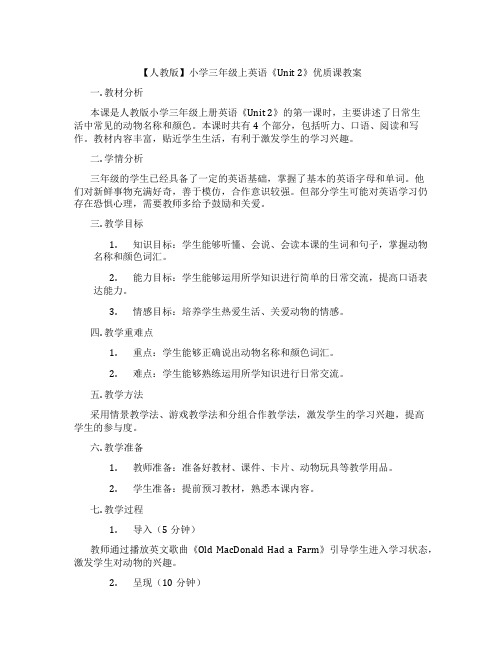
【人教版】小学三年级上英语《Unit 2》优质课教案一. 教材分析本课是人教版小学三年级上册英语《Unit 2》的第一课时,主要讲述了日常生活中常见的动物名称和颜色。
本课时共有4个部分,包括听力、口语、阅读和写作。
教材内容丰富,贴近学生生活,有利于激发学生的学习兴趣。
二. 学情分析三年级的学生已经具备了一定的英语基础,掌握了基本的英语字母和单词。
他们对新鲜事物充满好奇,善于模仿,合作意识较强。
但部分学生可能对英语学习仍存在恐惧心理,需要教师多给予鼓励和关爱。
三. 教学目标1.知识目标:学生能够听懂、会说、会读本课的生词和句子,掌握动物名称和颜色词汇。
2.能力目标:学生能够运用所学知识进行简单的日常交流,提高口语表达能力。
3.情感目标:培养学生热爱生活、关爱动物的情感。
四. 教学重难点1.重点:学生能够正确说出动物名称和颜色词汇。
2.难点:学生能够熟练运用所学知识进行日常交流。
五. 教学方法采用情景教学法、游戏教学法和分组合作教学法,激发学生的学习兴趣,提高学生的参与度。
六. 教学准备1.教师准备:准备好教材、课件、卡片、动物玩具等教学用品。
2.学生准备:提前预习教材,熟悉本课内容。
七. 教学过程1.导入(5分钟)教师通过播放英文歌曲《Old MacDonald Had a Farm》引导学生进入学习状态,激发学生对动物的兴趣。
2.呈现(10分钟)教师展示教材中的插图,引导学生说出图片中的动物和颜色。
教师出示卡片,让学生模仿发音,纠正发音错误。
3.操练(10分钟)教师学生进行小组活动,让学生互相提问动物和颜色,如:“What’s this? It’sa/an… What color is it?”学生用所学词汇进行回答。
4.巩固(5分钟)教师邀请学生上台展示自己的口语表达能力,其他学生进行评价。
教师给予鼓励和指导。
5.拓展(5分钟)教师引导学生发挥想象,用自己的语言描述一种喜欢的动物和颜色,学生互相分享。
七年级上英语 Unit 2(教案全)

七年级英语(上)Unit 2 This is my sister 教学稿The First Period (Section A 1a – 2c)Learning aims (学习目标)1. 学会表述家人的称谓。
2. 能听懂有关介绍家庭成员的对话。
2. 学会介绍家人。
3. 学会用特殊疑问句来询问家人的称谓。
Language points (语言点)1. 词汇:1)名词n. sister, mother, father, parent, brother, grandmother, grandfather, grandparent, family2)代词pron. those, who, these3)感叹词interj. oh2. 句型:This/That is …These/Those are …Who’s she? She’s …Difficulties (教学难点)1. 表示人物称谓的名词的读音及拼写。
2. 名词复数的正确使用。
【课前预习】Ⅰ.短语翻译:1.我的姐姐2.他的父亲3.你的母亲4.她的爷爷5.我的父母6.他的朋友7.你的哥哥8.她的祖父母Ⅱ. 补全句子:1. 这是我的弟弟。
_____ ______my ________.2. 那是他的妹妹。
_____ _______ his ________.3. 那些是她的朋友。
________ ________ her ___________.4. 这些是我的外祖父母。
_____ ________ my _________________.5. 这是你的妈妈吗?_________ __________ your ________?6. 那是她的爸爸吗?_________ ___________ her _____________?学习过程1. Warming-up and revision(课堂热身和复习)(1)Daily greetings to the students(2) RevisionT: Is he Eric? (指着班上的学生进行问答。
《Unit2Goingtoschool》优秀教案

Unit2 Going to choo第一课时一、教学重点本课时的教学重点:词汇:b bie, b bu, b car, on foot, wa, far from句型:How do ou come to choo I come to coo on foot教学栏目:Liten and aLoo and earn教学目标:1、帮助学生学习Loo and earn中的生词。
2、通过Liten and a的情景对话,帮助学生掌握句型How do ou come to choo I come to教学难点:本课时的教学难点是如何利用所提供的对话和情景,以旧引新,让学生进入学习状态。
三、课前准备1、教师准备教学过程中所需要的图片、声音、课件,以及本课时的单词卡。
2、准备一些照片或图片。
四、教学过程:一、Pre-ta rearation1、学生欣赏并轻声跟唱歌曲Thi i the wa2、教师用生词图片卡或多媒体出示各种交通工具,学生跟着教师一起做动作边诵读儿歌。
二、Whie-ta rocedure1、展示各种交通工具的图片,看图说话,教授核心句型及词汇。
2、学生听课文录音,回答相关问题。
3、学生在教师指导下阅读课文,完成下面的表格,再完成后续练习。
4、学生分角表演课文。
然后开展小组活动,在小组中分角表演对话。
三、Pot-ta activitie1、出示学生熟悉的不同场所的图片,让学生在真实的语境下,操练所学句型。
2、学生准备一些卡片,进行句型操练。
在一组卡片上写下目的地(如超市,图书馆,公园),另一组卡片上写上交通工具,安排学生分别抽取目的地和交通工具的卡片,然后师生问答。
三年级下英语Unit 2教案
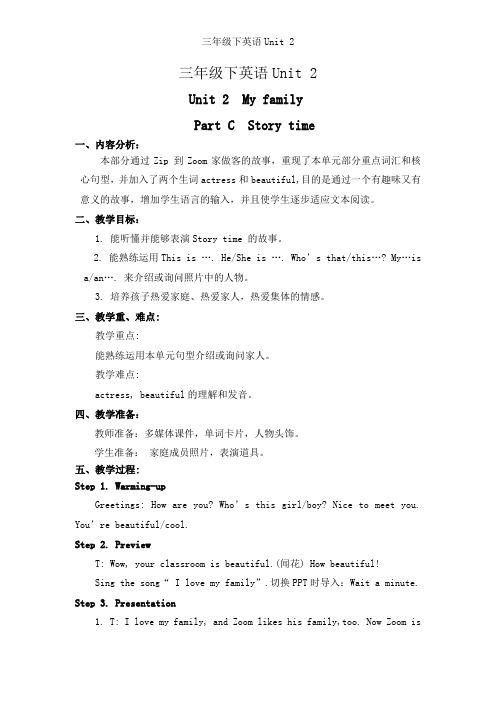
三年级下英语Unit 2Unit 2 My familyPart C Story time一、内容分析:本部分通过Zip 到Zoom家做客的故事,重现了本单元部分重点词汇和核心句型,并加入了两个生词actress和beautiful,目的是通过一个有趣味又有意义的故事,增加学生语言的输入,并且使学生逐步适应文本阅读。
二、教学目标:1. 能听懂并能够表演Story time 的故事。
2. 能熟练运用This is …. He/She is …. Who’s that/this…? My…is a/an…. 来介绍或询问照片中的人物。
3. 培养孩子热爱家庭、热爱家人,热爱集体的情感。
三、教学重、难点:教学重点:能熟练运用本单元句型介绍或询问家人。
教学难点:actress, beautiful的理解和发音。
四、教学准备:教师准备:多媒体课件,单词卡片,人物头饰。
学生准备:家庭成员照片,表演道具。
五、教学过程:Step 1. Warming-upGreetings: How are you? Who’s this girl/boy? Nice to meet you. You’re beautiful/cool.Step 2. PreviewT: Wow, your classroom is beautiful.(闻花) How beautiful!Sing the song“ I love my family”.切换PPT时导入:Wait a minute. Step 3. Presentation1. T: I love my family, and Zoom likes his family,too. Now Zoom istalking about his family with Zip. 切换PPT时重复:Wait a minute.带读。
2. T: Look at me! Look at the man. He’s….引导生说:He’s tall. T:Really? Yes, the man is tall. Look here,(指蝴蝶结) He’s cool.3. T: The man is cool. Here’s a woman. 教读“woman”.让生观看视频,回答:Who’s that woman?再次观看视频,选择:She’s tall/ cool/ beautiful.4. 指名学生读句子,T: You’re beautiful. 引导学生说:Thank you. 导入:The classroom is beautiful. The flowers are beautiful. PPT出示栀子花图,引导学生说:How beautiful!5. T: I’m a teacher. Is Zoom’s mother a teacher? 导入:She ’s an actress.出示明星图片,说明:They are actresses.6. T: Zoom’s mother is an actress. She has many beautiful clothes, maybe Zoom wants to wear the clothes, then what happened? T:Zoom likes his father and mother.They all like him. Zoom has a happy family. Step 4. Consolidation and extension1. 生自读故事;听录音跟读;分角色读;指名扮演。
英语必修二unit2教案

英语必修二unit2教案教案标题:Exploring Culture教学目标:1. 通过本单元的学习,学生将能够了解不同文化之间的差异以及文化对人的影响。
2. 培养学生的跨文化交流能力和批判性思维能力。
3. 提高学生的英语听、说、读、写的综合能力。
教学重点:1. 学习并掌握本单元的重点词汇和短语。
2. 理解并能够运用本单元的重点语法结构。
3. 阅读和理解与文化相关的文章。
4. 培养学生的口语表达和写作能力。
教学准备:1. 多媒体设备和相关教学素材。
2. 学生课本和练习册。
3. 教师准备的课堂活动和练习题。
教学过程:Step 1: Warm-up (5 minutes)1. 导入本单元主题,引起学生的兴趣。
可以通过展示一些与不同文化相关的图片或视频,让学生讨论并提出问题。
2. 引导学生思考不同文化之间的差异,并鼓励他们分享自己的观点和经历。
Step 2: Vocabulary and Reading (20 minutes)1. 教师通过多媒体展示本单元的重点词汇和短语,并进行解释和示范。
2. 学生跟读和模仿,并进行词汇练习。
3. 学生阅读课文,并回答相关问题,以检查他们的阅读理解能力。
4. 分组讨论课文中的文化差异和文化冲突,并汇报给全班。
Step 3: Listening and Speaking (15 minutes)1. 学生听一段关于跨文化交流的对话,并回答相关问题,以提高他们的听力理解能力。
2. 学生进行小组讨论,以分享自己的文化经验和观点。
3. 随机选择几个小组进行展示和讨论。
Step 4: Grammar and Writing (20 minutes)1. 教师讲解本单元的重点语法结构,并进行相关练习。
2. 学生进行写作练习,以描述自己所熟悉的文化活动或节日。
3. 学生互相交换作文,并进行修改和改进。
Step 5: Consolidation and Extension (10 minutes)1. 教师总结本节课的重点内容,并进行复习。
高一英语必修一unit2教案【5篇】

高一英语必修一unit2教案【5篇】高一英语必修一unit2教案【5篇】高一是同学适应高中英语学习的关键时期,作为一名高一英语老师,你知道如何写一篇英语教案?下面是我为你预备的高一英语必修一unit2教案,快来借鉴一下并自己写一篇与我们共享吧!高一英语必修一unit2教案精选篇5教学目标1. To practise listening comprehension.2.To practise making decisions and reasoning教学重难点1. To practise listening comprehension.2.To practise making decisions and reasoning教学工具课件教学过程Step1. revision1. check the homework exercises.1). It has been reported that children will be offered free education.It has been reported that free education will be offered to children.2). It has been said that we will be offered the latest computer science course book.It has been planned that the latest computer science course book will be offered to us.3). I have been told by Peter that I will be lent his notebook computer for a week.I have been told by Peter that his notebook computer will be lent to me for a week.2. Question: What can computers be used as?Step2. Lead-inAs we know, science and technology is developing very fast and computers have become smaller and smaller. They have been used in many fields. So, the 21st century is the century of information technology What does it mean? Does information technology/ IT only mean things like computers? Of cause not. Actually, it means more than computers. Computers are just one kind of IT. What else do you know is part of IT?(TV, radio, CD-ROM, DVD, books……)Step3. Listening (SB)1. Pre-listening: What are the changes brought by different forms of IT ?What are the advantages and disadvantages of them ?2. While-listening:Go through the chart and make sure the students look at the chart before they listen to the tape. (This is to sharpen their attention and listen for the answers. This will also help them get the gist of the text.) Then Listen to the tape and finish filling in the chart. (If necessary, play the tape for several times.)Say: After listening to their talk, we know all kinds of IT have both disadvantages and advantages.Let’s check the answers together.Type of IT Advantages DisadvantagesTV You can both listen and watch. You cannot write to friends.Web You can find information. It is very expensive.Radio You can listen to English. You cannot watch a film.Book You can get information. Sometimes it is out of date.3. Post-listening:1) (pair work): decide which type of IT is best for you to use right now. Make your choice and give your reasons by using the following expressions.I think that….In my opinion, ….I believe that….I agr ee because….I disagree because….I’ve decided that….2) (group work): Discussion :Computers are useful and have brought us lots of good things, but they also cause bad effects. What attitude should we have towards the computer? (Make good use of it but never get trapped by it.)Step4. Speaking1. Pre-speakingSay: From what we have learn, we should admit that computers and the web have a great influence on the school education as well as people’s life. It has come into people’s everyday life and many families hold computers in their homes. Now there is a task for you.2. While-speaking1) Situation: You have been asked by your parents to help choose computers for your home. You and your friend have looked at several computers. Talk about the special things each computer can do. Make a decision about which kind of computer to buy and explain why.Information input: Show students some pictures of different computers (desktop computer laptop computer …)Language input: Useful expressions (Repeat it to strengthen students’ ability of use it.)Supporting an opinion Challenging an opinionI think that … , because … Perhaps, but what if / about …First, … Have you thought about …One reason is that … What makes you think thatI think it is better because… I don’t like it because….(Pair work )Use the expressions to support your opinion or challenging other’s opinions.2) Oral report: (individual work )Do an oral report to your father and start your report like this: I looked at many different computers. The one I have chosen is the PEP personal computer. One of the main reasons is that it is suitable for homes. I found that…3. Post-speakingConclusion—What useful expression do we use to make a decision and reason?(In this way, they can review and use the words and phrases again.)Step6 Pre-writingSay: Imagine what problems and delights this android might have to deal with while it is serving you. Try yourself in someone else’s shoes is an important way of understanding how other people feel.Then discuss: You are an android. You work for a family with one child who is very spoiled. The parents want you to do everything for them. The parents are nice, but they often ask you to watch over their child. How do you feel? What would you do if the child asked you to do his/her homework for him/her? Would you ever tell the child “no”?Step7 WritingSay: Write a passage about the result of your discussion! It should contain:What do you have to do?What is the child like?What is the parents’ requirement of the child?What do the parents want you to do?What does the child want you to do?Then what will you do? How do you feel?Sample writing:Hello everybody, my name is Liu Yan.I am a 321 model android.I work for the Li family. Mr and Mrs Li work very hard too.Mr Li is an architect and designs great tall apartment blocks.Mrs Li is a doctor and has to look after many patients.I remember all the plans for Mr Lis projects and can tell Mrs Li which drugs are the best to give any particular patient. And I also look after their library. I store all the books that they borrow from their school or friends in my brain.Of course my brain is as large as a mountain, so work like that is no trouble to me.I really eat books just like people eat food.The Lis have a child who is very spoiled. He needs me to remember all his school textbooks so that I can do his homework for him.He just gives me the information on the subject, what has to be done and the page numbers and I get on with it while he enjoys himself with his friends.Sometimes I dont think it is right to do his homework for him — its somewhat cheating. However, his parents are very concerned at the pressure of work in school these days.The child has too much homework to do. They like him to go to the key school but they also want him to be able to have hobbies, learn to swim and keep fit! Poor child!So they consider me the most important person in the family after themselves.I am always introduced to their friends and play with visiting children.I am the perfect family academic aid and, although I was not cheap to buy, Mr Li says I was worth every yuan!Step8 AssessmentGet the students to assess their writing ability according to the following the questions:1. Is your composition well developed?2. Are your ideas well organized to the point?3. Do you have a good choice of words and idioms in your writing?4. Do you get a good mastery of complex structures of language?5. What kind of mistakes have you made in your writing?Step9: HomeworkWrite about your discussion. You may begin like this:Hello, everyone. My name is __X. I’m 321 model android.I work for the Li family….课后小结学了这节课,你有什么收获?课后习题完成课后习题一、二。
人教版七年级英语下册unit2教案

人教版七年级英语下册unit2教案人教版七年级英语下册unit 2教案(一)Unit 2 Section B (1a-2c)一、教学目标:1. 语言知识目标:1) 能掌握以下单词:half, past, quarter, homework, run, walk, clean, quickly, either, either…or…2) 能掌握以下句型:① —When does T om usually get up?—He usually gets up at half past five.② I either watch TV or play computer games.③ It tastes good.2. 情感态度价值观目标:本部分的学习内容仍是对―日常作息时间‖人教版七年级英语下册unit 2教案(二)教学重难点1. 教学重点:1) 让学生们掌握另外两种表达时间的方式。
2) 3)2. 教学难点1) 能听懂学习到的日常活动的时间按排。
2)人教版七年级英语下册unit 2教案(三)教学过程Ⅰ. Warming- up and revision1. Greet the Ss as usual.2. Check the homework.Ⅱ. PresentationWhat timeis it?”。
…和to来回答时间:(1) ―时‖,再说―分‖。
如:six thirty 六点半;seven fifteen七点十九点五十五分。
(2) 先说―分‖,再说―时‖,中间加介词past(半点或半点以内,表示―超过‖)、to(半点以上,表示―差‖)。
如:五点十分;。
quarter past seven 七点一刻;half past nine 九点半;a quarter to twelve十二点差一刻,即十一点四十五分。
Ⅲ. Matching1. Work on 1a: 引导学生将用英语表达的时间与钟表上用数字表达的时间一一配对。
(完整版)unit 2 what time do you go to school 全单元教案

Unit 2 Period 1 (1a-2c)Teaching aims:1. Can use the words:up, get up, dress, get dressed, brush, tooth (pl。
teeth) brush teeth,shower, take a shower, usually, forty, fifty, wow, never, early.2. Ask about and say times.—What time do you usually get up? —I usually get up at six thirty。
Teaching key points and difficulty:1。
Ask about and say times.2。
Talk about daily routinesAbility aims:1. Improve students’ listening and speaking skills.2. Improve students’ communication competence。
Moral aims“Time is money and time is life。
” Everyone should make full use of time。
教材分析:复习巩固 Numbers 1–301a 呈现动词短语,图片直接呈现,1b 练习时刻的表达,ask and answer,句型比较简单。
1c 巩固练习。
Step 1 .Warm—up and revision。
1. Daily greetings to the Ss。
2。
Revision:the numbers(1—60)Step 2 Ask about the times。
1。
Show the clocks and ask them: -What’s this in English?-What time is it?2. talk about and say timesTeach the students to say times。
外研社英语必修三unit2教案
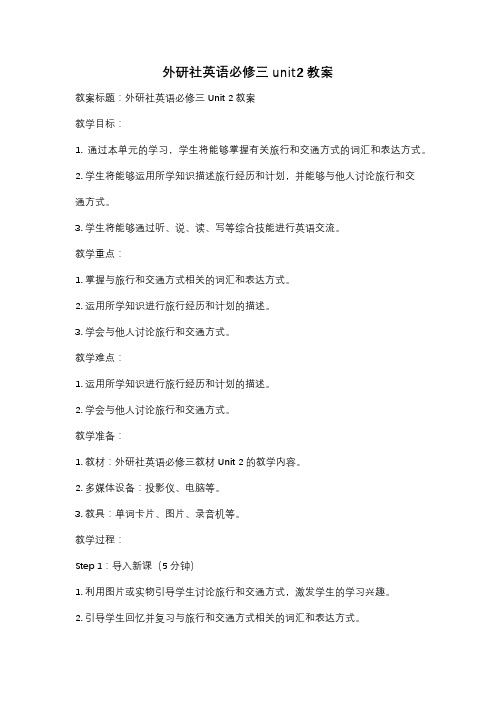
外研社英语必修三unit2教案教案标题:外研社英语必修三Unit 2教案教学目标:1. 通过本单元的学习,学生将能够掌握有关旅行和交通方式的词汇和表达方式。
2. 学生将能够运用所学知识描述旅行经历和计划,并能够与他人讨论旅行和交通方式。
3. 学生将能够通过听、说、读、写等综合技能进行英语交流。
教学重点:1. 掌握与旅行和交通方式相关的词汇和表达方式。
2. 运用所学知识进行旅行经历和计划的描述。
3. 学会与他人讨论旅行和交通方式。
教学难点:1. 运用所学知识进行旅行经历和计划的描述。
2. 学会与他人讨论旅行和交通方式。
教学准备:1. 教材:外研社英语必修三教材Unit 2的教学内容。
2. 多媒体设备:投影仪、电脑等。
3. 教具:单词卡片、图片、录音机等。
教学过程:Step 1:导入新课(5分钟)1. 利用图片或实物引导学生讨论旅行和交通方式,激发学生的学习兴趣。
2. 引导学生回忆并复习与旅行和交通方式相关的词汇和表达方式。
Step 2:新课讲解(15分钟)1. 通过多媒体展示单词和短语的图片,引导学生学习和掌握新词汇和表达方式。
2. 通过示范和练习,帮助学生理解和掌握新课的语法和用法。
Step 3:听说训练(20分钟)1. 播放录音,让学生跟读和模仿录音内容,提高学生的听力和口语能力。
2. 分组讨论旅行经历和计划,学生之间进行信息交流和对话练习。
Step 4:阅读训练(15分钟)1. 分发阅读材料,让学生阅读并理解文章内容。
2. 组织学生进行小组讨论,回答与文章相关的问题。
Step 5:写作训练(20分钟)1. 引导学生根据所学知识,写一篇关于自己旅行经历或计划的短文。
2. 学生互相交换短文,进行修改和改进。
Step 6:课堂总结(5分钟)1. 教师对本节课的重点内容进行总结和回顾。
2. 学生提问和解答疑惑。
Step 7:作业布置(5分钟)1. 布置相关的课后作业,巩固所学知识。
2. 鼓励学生自主学习和探究,提高英语学习的兴趣和能力。
人教版八年级英语上册-Unit2-教案
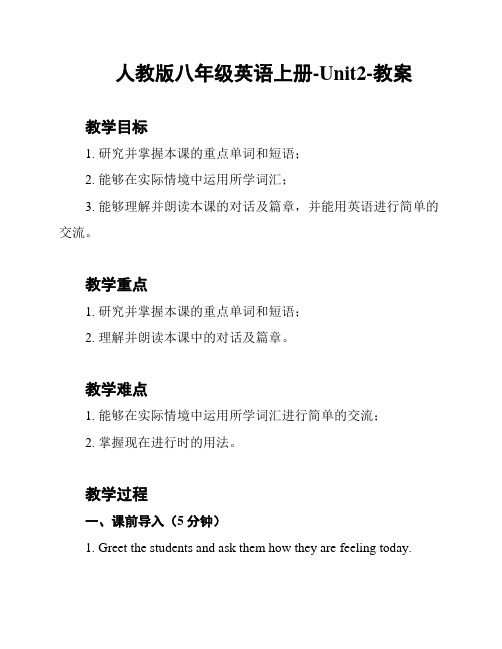
人教版八年级英语上册-Unit2-教案教学目标1. 研究并掌握本课的重点单词和短语;2. 能够在实际情境中运用所学词汇;3. 能够理解并朗读本课的对话及篇章,并能用英语进行简单的交流。
教学重点1. 研究并掌握本课的重点单词和短语;2. 理解并朗读本课中的对话及篇章。
教学难点1. 能够在实际情境中运用所学词汇进行简单的交流;2. 掌握现在进行时的用法。
教学过程一、课前导入(5分钟)1. Greet the students and ask them how they are feeling today.2. Show some pictures on the screen and try to ask them what the pictures are about.二、自主研究(35分钟)1. 学生们自主研究课文,并做好笔记,记录不熟悉的内容和需要了解的疑点。
2. 学生们可以在自主研究的过程中互相讨论并互相帮助。
三、交流展示(15分钟)1. 当做完自主研究后,老师开始组织学生展示他们的研究成果,展示方式并不限定,有朗读、问答等,总之要把研究到的知识用出来,让知识得到巩固。
2. 学生们可以相互交换信息或者反馈,梳理研究内容,发现问题。
四、课堂总结(5分钟)1. 了解本节课的教学内容,培养学生研究语言的兴趣。
2. 学生们要及时复和总结,才能让这些知识真正掌握。
教学板书设计1. 本课的重点单词和短语。
2. Was he doing exercise? Yes, he was.课后作业1. 完成本课课后的题。
2. 总结课上学到的内容。
Unit 2 It's a circle 教案

Unit 2 It’s a circle教案一、教学重点词汇:circle, square, line, dot.二、教学栏目Look and learn, Draw and say三、教学目标1.帮助学生学习表示形状的单词。
2.通过Draw and say画画说说不同形状的事物,帮助学生巩固所学生词。
四、教学步骤Pre-task preparations为渲染学习气氛。
拿出一张正方形的纸,接着将纸对折呈现一个三角形,然后再换一种方式对折呈现一个长方形。
通过演示,引出单元话题“形状”。
T: (point at the paper) Look at the paper. It’s a square.(fold the paper and point at the shape)Look, is it a square now?S2: No, it isn’t.T: It’s a triangle. (fold the paper in another way and point at the shape) Is it a triangle?S1: No, it isn’t.While-task procedures1.出示Look and learn栏目中的单词图片,学生在理解意思的基础上仔细听其发音后进行模仿,并进行拼读。
模仿和拼读活动可以是集体的,也可以是个别的。
T: (show the flashcard for square) Look, it’s a square. Square. S-Q-U-A-R-E, square.Ss: Square. S-Q-U-A-R-E, square.2.What’s missing? 游戏。
将所有单词图片呈现给学生,任意抽走一张,让学生说出被抽走的单词。
前几次可以通过图片消失形式,后面几次可以是以单词消失的形式。
然后让学生集体拼读这些单词。
T: What’s missing?S1: A circle.Ss: Circle. C-I-R-C-L-E, circle.3.让学生做Draw and say,在一张白纸上画一画生活中常见的与这些形状匹配的东西,每个形状画一样。
- 1、下载文档前请自行甄别文档内容的完整性,平台不提供额外的编辑、内容补充、找答案等附加服务。
- 2、"仅部分预览"的文档,不可在线预览部分如存在完整性等问题,可反馈申请退款(可完整预览的文档不适用该条件!)。
- 3、如文档侵犯您的权益,请联系客服反馈,我们会尽快为您处理(人工客服工作时间:9:00-18:30)。
课时教学设计课题:Unit 2(第一课时)备课人:上课人:教学目标:1. 学习单词weekend, drank, show, anything, else.2. 全体学生能使用:What did you do? I stayed at home with your grandma. We drank tea in the afternoon and watched TV.3. 掌握动词过去式的句子。
4. 能朗读课文,并能实行角色表演。
在小组的讨论交流中,培养学生英语的综合使用水平。
教学重点:重点是掌握A-Let’s learn的四会单词和短语,并询问别人的身体状况。
教学难点:全体学生能掌握重点单词及句型。
教具学具课件准备录音机、磁带、图片第几课时: 1探索流程个性添加(教学反思)Step 1:greetingT:hello boys and girls.S:hello MS Wang.T:good morning/good afternoon class.S:good morning/good afternoon MS Wang.T:nice to see you again.S:nice to see you, too.Step 2:warmerReview some words we have studied in last class.Dialogue practice.播放Let’s try的录音Step 3 presentation(1)生阅读let’s talk的短文并圈出不理解的单词:was drank(2)师讲解:drink—drankam. is---wasare----were(3)教师播放Let’s talk 的课件,并要求学生回答问题:what did mike’s grandpa do last weekend?(4)教师再次播放Let’s talk 的课件,学生跟读并思考问题:How was your weekend?What did you do last weekend?What are you going to do next weekend?Step 4 practice(1)role-play两人一组练习对话,并请三组上台表演(2)make a report向全班讲述自己的上个周末做了哪些事情。
板书设计作业布置Unit 2 Last WeekendWhat did you do last weekend?I ……drink—drankam. is---wasare----were(1)学生听读P14-16两遍。
(2)学生背诵和抄写单词和短语4遍。
课题:Unit 2 (第2课时) 备课人:上课人:教学目标:1.能听,说,读,写短语:cleaned my room, washed my clothes , stayed at home, watched TV .2.能听懂问句:what did you do?并能做出相对应的回答。
3能够使用新学的内容完成“Do a survey and report”任务。
4.掌握动词过去式的句子。
5.在小组的讨论交流中,培养学生英语的综合使用水平。
教学重点:四个动词短语的读音和拼写教学难点:,掌握动词的过去式变化规则及其发音教具学具课件准备相关卡片,磁带等。
第几课时:2探索流程个性添加(教学反思)Step 1:greetingT:hello boys and girls.S:hello MS Wang.T:good morning/good afternoon class.S:good morning/good afternoon MS Wang.T:nice to see you again.S:nice to see you, too.Step 2:warmer1.日常口语练习T:Good morning, boys and girls, who can tell me what do you usually do on weekends?S1:I usually do my homework….S2:………..2. warm-up导入新课T:OK .How was your weekend?S3:It was fine….S4:……..Step 3 presentation出示课件并让学生自己观察回答问题。
1.T:How were their weekend?S1:MIKE cleaned his room and washed his clothes.(师注意物主代词的变换)S2:ChenJie stayed at home and watched TV.(1)表现词组:cleaned my room, washed my clothes , stayed at home, watched TV 强调过去式的发音/d/,/d/,/id//t/.学生跟随教师朗读词组。
(2)表现句型:What did you do? 师问生答。
(3)生打开课本P15,听录音再次跟读。
Step 4 practice(练习)(1)卡片识单词:教师出示动词原形词组卡片学生说动词词组的过去式(2)主情景图问答练习:出示MIKE 微博截图,操练句型what did +主语+do? 主语+动词过去式(3)Do a survey and report:操练句型—How was your weekend? What did you do?(4)summary:Last weekend two students washed their clothes…板书设计作业布置Unit 2 Last Weekendclean-----cleaned my roomwash-----washed my clothesstay-------stayed at homewatch-----watched TV (1)抄写四会动词词组并做配套练习(2)询问同学及朋友的周末安排(3)预习p16教学目标:1.能够了解le t’s talk的大意,并能简单复述对话。
2.能听懂并能完成part B Let’s try.3.能够了解单词magazine,better,faster的意思。
4.培养学生准确的兴趣爱好.教学重点:Let’s talk 动词过去式的变化规则.w W 教学难点:能在生活中灵活使用对话.教具学具课件准备相关卡片,磁带等。
第几课时:3探索流程个性添加(教学反思)Step 1:greetingT:hello boys and girls.S:hello MS Wang.T:good morning/good afternoon class.S:good morning/good afternoon MS Wang.T:nice to see you again.S:nice to see you, too.Step 2:warmer1.日常口语练习2.播放Let’s try录音,并完成相对应的练习Step 3:presentation1. 教师展示自己昨天做的事情,和平时周末经常做的事情的图片,引导学生注意时态的区别.2. 教师对学生说:john and amy正讨论想要去书店,他们要买什么呢?let’s havea look!3. 播放let’s talk活动的动画或录音,请学生看动画或听录音,教师通过简单的提问协助学生理解课文大意。
4. What do they want to buy?5. 教师通过单词卡片,图片,事物,带领学生学习单词及短语,magazine, had a cold, slept, better, faster.通过教师领读,小老师领读,组长检查,熟练掌握单词。
6. 再次播放录音。
7. 思考did john see a film last weekend?/ what did he do?8. 小组讨论,找出答案,抽生回答。
9. 再次播放录音,跟读,要求生模仿语音语调。
10. 生分角色朗读,男女生读,分组读板书设计作业布置Unit 2 Last Weekendmagazine 杂志better---good 更好faster---fast 更快better 听录音模仿对话预习p17.课题:Unit 2 (第4课时) 备课人:上课人:教学目标:能听,说,读,写短语:read a book , saw a film ,had a cold, slept.能听,说,会读时间短语:last weekend, last night, last Monday, yesterday, the day before yesterday 并能做出相对应的替换.掌握过去式的一般疑问句的形式:Did you like it?Yes,I did并知道关键词替换。
能独立完成Look and talk的练习教学重点:能听,说,读,写短语:read a book , saw a film ,had a cold, slept 教学难点:动词过去式的一般疑问句及其回答。
教具学具课件准备相关卡片,磁带等。
第几课时:4探索流程个性添加(教学反思)Step 1:greetingT:hello boys and girls.S:hello MS Wang.T:good morning/good afternoon class.S:good morning/good afternoon MS Wang.T:nice to see you again.S:nice to see you, too.Step 2:warmer(1)日常口语练习(2)复习Step 3:presentation(新课表现)(1)PPT出示John的微博截图并提出问题:T:what did John do last Saturday?(板书last Sunday)S1:He slept.(板书slept)S2:He read a book(板书read a book)(2)出示动词卡片,学生朗读,(3)出示Sarah看电影的图片,学生猜动词词组:see a film,引出saw a film(板书saw a film).学生跟读(4)T:Sarah saw a film. Did you like it?(板书Did you like it?)S1:Yes,I did(板书)S2:No,I didn’t(板书)(5)出示John 感冒的图片:have a cold ,引出动词的过去式had a cold(板书had a cold).学生跟读(6)学生打开课本练习Let’s learn 的对话,教师出示各种时间词并解释:the day before yesterday(后天)(7)小结:不规则动词过去式:do---did see---saw read---readsleep---slept have ----had go---wentstep4:practice(练习)1. Look and talk :操练句型what did Sarah/John/Mike….do yesterday/last Sunday /……? Did he/she have a cold…..?Yes, he/she did ,No, he /she didn’t2. 小结板书设计作业布置Unit 2 Last Weekendread a booklast weekend,saw a filmlast night,had a coldlast Monday, slept yesterday,the day before yesterday (1)(抄写动词词组即时间短语(2)听录音模仿对话(3) 预习P18课题:Unit 2 (第5课时)备课人:上课人:教学目标:1. 能听,说,认读单词hotel,fixed,broken,lamp,loud,enjoy,stay2. 能够了解read and write 课文的部分大意3. 了解意见书书写格式4. 学生能在任务完成的过程中体会新语言的意义教学重点:read and write的对话教学难点:知道基本的酒店入住礼仪教具学具课件准备相关卡片,磁带等。
